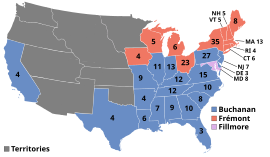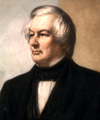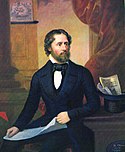Präsidentschaftswahl in den Vereinigten Staaten 1856
| ‹ 1852 • | |||||||||||
| 18. Präsidentschaftswahl | |||||||||||
| 4. November 1856 | |||||||||||
| Demokratische Partei | |||||||||||
| James Buchanan / John C. Breckinridge | |||||||||||
| Wahlleute | 174 | ||||||||||
| Stimmen | 1.836.072 | ||||||||||
| 45,3 % | |||||||||||
| Republikanische Partei | |||||||||||
| John C. Frémont / William L. Dayton | |||||||||||
| Wahlleute | 114 | ||||||||||
| Stimmen | 1.342.345 | ||||||||||
| 33,1 % | |||||||||||
| Know-Nothing Party | |||||||||||
| Millard Fillmore / Andrew Donelson | |||||||||||
| Wahlleute | 8 | ||||||||||
| Stimmen | 873.053 | ||||||||||
| 21,5 % | |||||||||||
| Wahlergebnisse nach Bundesstaat | |||||||||||
 | |||||||||||
19 Staaten Buchanan/Breckinridge | 11 Staaten Frémont/Dayton | ||||||||||
1 Staat Fillmore/Donelson | |||||||||||
| Gewähltes Electoral College | |||||||||||
| Electoral College: | |||||||||||
| Präsident der Vereinigten Staaten | |||||||||||
Die Präsidentschaftswahl in den Vereinigten Staaten 1856 fand am 4. November 1856 statt. Es war die 18. Wahl des Präsidenten der Vereinigten Staaten. Der Demokrat James Buchanan gewann gegen den Kandidaten der neu gegründeten Republikanischen Partei, John Charles Frémont, und den Know-Nothing/American Party-Kandidaten Millard Fillmore.
Kandidaten
Demokratische Partei
Die Demokraten übergingen bei ihrer Nominierung den amtierenden Präsidenten Franklin Pierce. Im 17. Wahlgang setzte sich der Senator von Pennsylvania James Buchanan als Kompromisskandidat durch. Sein Mitkandidat wurde John Cabell Breckinridge aus Kentucky.
Republikanische Partei
Bei den Republikanern konnte der Entdecker John Charles Frémont das Rennen um die Nominierung gegen den New Yorker Senator William H. Seward für sich entscheiden. Mit ihm trat der aus New Jersey stammende frühere Senator William Lewis Dayton an.
Know-Nothing Party
Die American Party nominierte den früheren Whig-Präsidenten Millard Fillmore mit Andrew Jackson Donelson aus Tennessee als Kandidat für die Vizepräsidentschaft.
Wahlkampf
Der Wahlkampf der Republikaner richtete sich gegen die „Zerstörung republikanischer Werte“ durch die amtierende demokratische Regierung von Pierce durch Maßnahmen wie den Kansas-Nebraska Act, der neuen Staaten die Entscheidung über ihren Status als freier oder Sklavenstaat überließ, und gegen die angestrebte Annexion Kubas (siehe Ostende-Manifest).
Die Demokraten warnten, dass ein Wahlsieg der Republikaner zur Sezession einzelner Staaten und zum Bürgerkrieg führen werde. Dies bewahrheitete sich nach den nächsten Wahlen (siehe Sezessionskrieg).
Die Know-Nothing- oder American Party agitierte für die Bekämpfung der Einwanderung, insbesondere aus katholischen Ländern, sowie die Einführung strengerer Einbürgerungsgesetze. Sie zog daneben Südstaatler wie Nordstaatler an, die besorgt über die drohende Spaltung des Landes waren.
Wahl
Fremont erhielt in den Südstaaten gerade 600 Stimmen, konnte aber im Nordosten und Norden die meisten Staaten gewinnen. Besonders umstritten zwischen Buchanan und Frémont waren Illinois, Indiana, Iowa, New Hampshire und Ohio. Fillmore konnte besonders viele Stimmen in den „Grenzstaaten“ zwischen Nord und Süd, darunter Kentucky, Maryland (das er gewann), Missouri und Tennessee, erringen, aber auch in Staaten wie Louisiana und Georgia ein Zeichen setzen. In dem bevölkerungsreichen Staat Pennsylvania sowie in Kalifornien, Illinois und New Jersey konnte Buchanan dank der Dreifachkandidatur mit einfacher Mehrheit gewinnen.
Buchanan gewann 174 Wahlmännerstimmen, 25 mehr als er benötigte, um eine Entscheidung durch das Repräsentantenhaus gemäß dem 12. Amendment zu verhindern. Entscheidend war sein Gewinn der Staaten Pennsylvania (27 Wahlmänner), Indiana (13) und Illinois (11). Im Ganzen war sein Sieg durchaus komfortabel, jedoch konnte Frémont das Potential der erst zwei Jahre alten Republikanischen Partei eindrucksvoll unterstreichen. Mit dem Ausscheiden der American Party bei den folgenden Wahlen 1860 und der Spaltung der Demokratischen Partei war der Weg für den Wahlsieg Abraham Lincolns geebnet.
Mit 79 % war die Wahlbeteiligung die bisher viertgrößte bei Präsidentschaftswahlen.[1]
Ergebnis
| Kandidat | Partei | Stimmen | Wahlmänner | ||
|---|---|---|---|---|---|
| Anzahl | Prozent | ||||
| James Buchanan | Demokraten | 1.836.072 | 45,3 % | 174 | |
| John Charles Frémont | Republikaner | 1.342.345 | 33,1 % | 114 | |
| Millard Fillmore | Know-Nothing | 873.053 | 21,6 % | 8 | |
| Gesamt | 4.054.647 | 99,9 % * | 296 | ||
* an 100 % fehlende Prozent: ungültige Stimmen / andere Kandidaten
Literatur
- Donald Richard Deskins, Hanes Walton, Sherman C. Puckett: Presidential Elections, 1789-2008: County, State, and National Mapping of Election Data. University of Michigan, Ann Arbor 2010, ISBN 978-0-472-11697-3, S. 155–166 (= Kapitel 20: James Buchanan’s Election.).
Weblinks
- Stimmverteilung in den einzelnen Staaten
- Sebastian Hollstein: Der schlechteste US-Präsident der Geschichte, In: spektrum.de, 15. Oktober 2020
Anmerkungen
- ↑ Jean H. Baker: James Buchanan. (= The American Presidents Series. Hrsg. von Arthur M. Schlesinger, Sean Wilentz. The 15th President). Times Books, New York City 2004, ISBN 0-8050-6946-1, S. 72.
Auf dieser Seite verwendete Medien
This portrait of John C. Fremont was created by Bass Otis, who died in 1861
Portrait of James Buchanan, serving (1857-1861) as 15th President of the United States
"The Great Republican Reform Party Calling on their Candidate", an 1856 print which is a political cartoon about John C. Frémont, the first Republican party candidate for president of the United States. In the 1840's and 1850's, radical social reform movements (such as slavery abolitionism, alcohol prohibitionism, pacifism, socialism, and after 1848, feminism) and/or what were considered eccentric currents of thought (such as Transcendentalism, Mormonism, Oneida, "spirit-rappers" or Spiritualism, etc.) were sometimes stigmatized by being lumped together as "the Isms". Southerners often prided themselves on the American South being free from all of the pernicious Isms (except for alcohol temperance campaigning, which was fully compatible with traditional Protestant fundamentalism). For example, on Sept. 5th and 9th 1856, the Richmond, Virginia Examiner ran editorials on "Our Enemies, the Isms and their Purposes", while in 1858 "Parson" Brownlow" called for a "Missionary Society of the South, for the Conversion of the Freedom Shriekers, Spiritualists, Free-lovers, Fourierites, and Infidel Reformers of the North" (reference: The Freedom-of-thought Struggle in the Old South by Clement Eaton). And George Fitzhugh wrote "Why have you Bloomers and Women's Right's men, and strong-minded women, and Mormons, and anti-renters, and 'vote myself a farm' men, Millerites, and Spiritual Rappers, and Shakers, and Widow Wakemanites, and Agrarians, and Grahamites, and a thousand other superstitious and infidel Isms at the North? Why is there faith in nothing, speculation about everything?"[1]
This cartoon seeks to stigmatize the Fremont campaign and the Republican party (which was the first broadly-successful political party in United States history to firmly and unyieldingly oppose all attempts at the geographical expansion of slavery) by associating them with the "Isms", most of which were politically very controversial (and some of which were considered to be offensively immoral by many) at the time. The advocates of the Isms are shown making demands on Fremont:
- Advanced Fourierist/Transcendentalist thinker
- "The first thing we want is a law making the use of Tobacco, Animal food [i.e. meat], and Lager-bier a Capital Crime --"
- Woman wearing an extremely masculinized version of the Bloomer costume (with straight pants instead of harem pants, and extremely short skirts over them), and also smoking (which was considered a masculine prerogative at the time)
- "We demand, first of all, the recognition of Woman as the equal of man, with a right to Vote and hold Office. --"
- Roughly-dressed character, holding liquor bottle
- "An equal division of property, that is what I go in for --"
- Ugly woman (from Oneida?) wearing a dress with poorly-constructed narrow hoops (at a time when fashionable belles wore very broad hoops, while women who declared their relative independence from ephemeral fashion trends didn't wear hoops at all)
- "Col., I wish to invite you to the next meeting of our Free Love association, where the shackles of marriage are not tolerated, & perfect Freedom exists in love matters, and you will be sure to enjoy yourself, for we are all Freemounters. --" [this last word a double entendre]
- Catholic prelate
- "We look to you, Sir, to place the power of the Pope on a firm footing in this Country--"
- Black man in exaggerated faux-dandy attire (representing abolitionism)
- "De Poppylation ob Color comes in first -- arter dat [after that], you may do wot you pleases--"
- Fremont
- "You shall all have what you desire -- and be sure that the Glorious Principles of Popery, Fourierism, Free Love, Woman's Rights, the Maine law [alcohol prohibition], & above all the Equality of our Colored Brethren shall be maintained if I get into the Presidential Chair".
The cartoonist was motivated by political expedience in grouping Catholicism together with the more commonly-recognized "Isms" (which leads to a certain degree of internal inconsistency in the cartoon); it was the Democratic party which was more often accused of relying on the support of Catholic immigrants, whose presence some considered dangerous to the American political system. However, there was a political campaign smear rumor current in 1856 that Fremont was a Catholic (the purpose of which was to prevent Fremont from gaining support from those who were suspicious of Catholics).
Edited from image http://memory.loc.gov/master/pnp/cph/3a10000/3a12000/3a12700/3a12793u.tif on the Library of Congress website.
Bibliographic information found on the LoC site:
TITLE: The great Republican Reform Party, calling on their candidate
CALL NUMBER: PGA - Currier & Ives--Great republican... (B size) [P&P]
REPRODUCTION NUMBER: LC-USZ62-10370 (b&w film copy neg.)
SUMMARY: Fremont is portrayed as the champion of a motley array of radicals and reformers. As he stands patiently at far right he is "called upon" by (left to right): a temperance advocate, a cigar-smoking, trousered suffragette, a ragged socialist holding a liquor bottle, a spinsterish libertarian, a Catholic priest holding a cross, and a free black dandy. Temperance man: "The first thing we want, is a law making the use of Tobacco, Animal food, and Lager-bier a Capital Crime". Suffragette: "We demand, first of all; the recognition of Woman as the equal of man with a right to Vote and hold Office". Socialist: "An equal division of Property that is what I go in for". Elderly libertarian: "Col. I wish to invite you to the next meeting of our Free Love association, where the shackles of marriage are not tolerated & perfect freedom exist in love matters and you will be sure to Enjoy yourself, for we are all Freemounters". Priest: "We look to you Sir to place the power of the Pope on a firm footing in this Country". Freedman: "De Poppylation ob Color comes in first. arter dat, you may do wot you pleases". Fremont: "You shall all have what you desire. and be sure that the glorious Principles of Popery, Fourierism, Free Love, Woman's Rights, the Maine Law, & above all the Equality of our Colored brethren, shall be maintained; If I get into the Presidential Chair".
MEDIUM: 1 print on wove paper : lithograph ; image 30 x 39 cm.
CREATED/PUBLISHED: N.Y. : For Sale [by Nathaniel Currier] at no. 2 Spruce St., [1856]
CREATOR: N. Currier (Firm)
RELATED NAMES: Maurer, Louis, 1832-1932, artist.
NOTES: Title from item. Probably drawn by Louis Maurer. The Gale catalog describes another, earlier state of the print, with only "ferences". Currier & Ives : a catalogue raisonné‚ / compiled by Gale Research. Detroit, MI : Gale Research, c1983, no. 2867. Weitenkampf, p. 117. Murrell, p. 185. Published in: American political prints, 1766-1876 / Bernard F. Reilly. Boston : G.K. Hall, 1991, entry 1856-22.
TOPICS:
- Abolitionism and abolitionists and the Kansas Strife.
- African Americans (portrayed).
- Catholic Church, hostility toward.
- Temperance movement.
- Women and women's rights.
FORMAT: Political cartoons 1850-1860. Lithographs 1850-1860.
REPOSITORY: Library of Congress Prints and Photographs Division Washington, D.C. 20540 USA
DIGITAL ID: (b&w film copy neg.) cph 3a12793 http://hdl.loc.gov/loc.pnp/cph.3a12793
CARD #: 2003656588Portrait of Millard Fillmore.
1856 Electoral College















